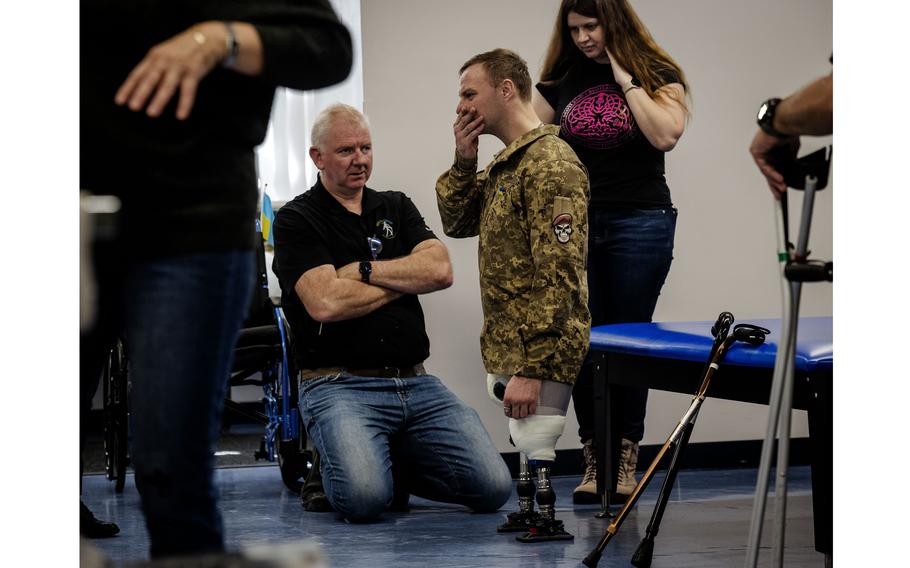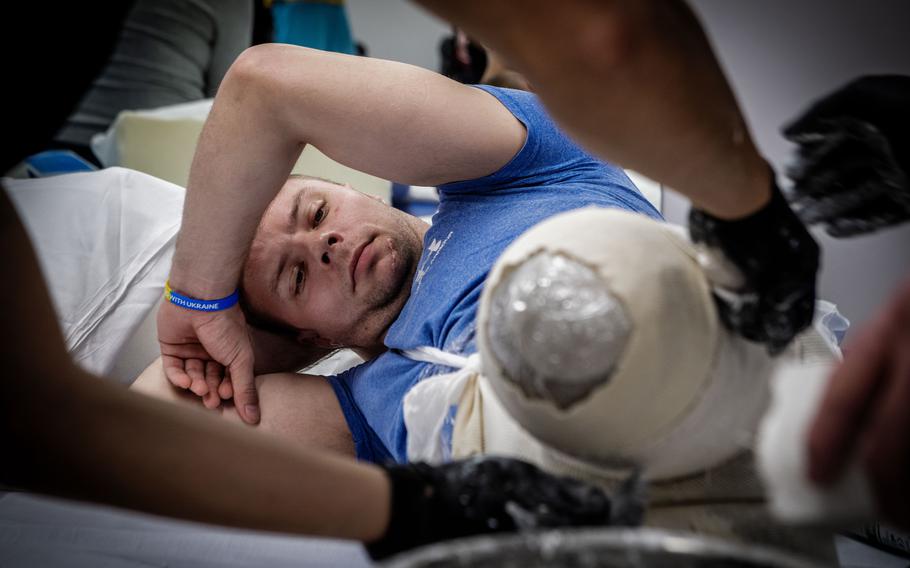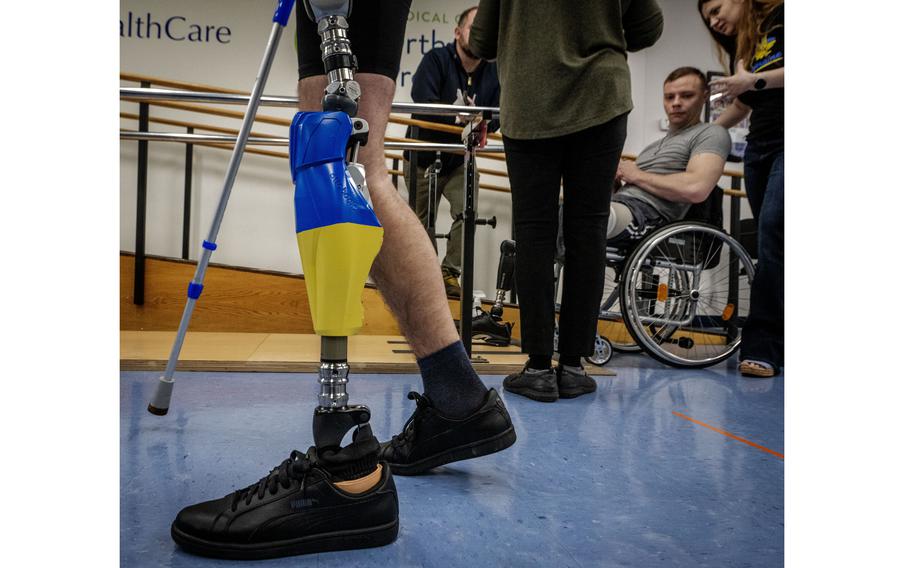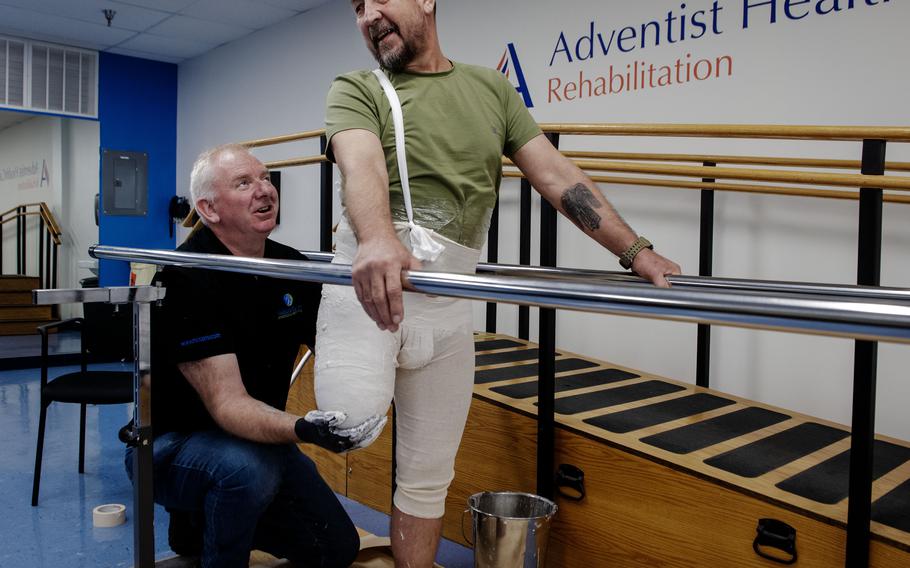
Oleksander Fedun, one of the Ukrainian soldiers getting replacement limbs at Medical Center Orthotics and Prosthetics in Silver Spring, Md., discusses the fit of his new prosthetic legs with Mike Corcoran, left, while volunteer Hanna Ortiz interprets. (Bill O’Leary/The Washington Post)
The ground was a thicket of Russian land mines. Lethal. Too many to avoid. Oleksandr Fedun, a soldier in the Ukrainian army, remembers driving through the field and then a roar of fire, shrapnel and light.
He leaped from the wreckage of his self-propelled howitzer. What was left of his legs snapped and splintered when he hit the earth, alive — miraculously — and with enough presence of mind to slip on two tourniquets. The field hospital, though, was hours away.
That was in May, as Ukrainian troops in the country’s southeast blitzed pockets of Russian forces in limited counteroffensives. Six months later, Fedun, 23, was in suburban D.C., ready to attempt what his doctors back home had said was unlikely ever to happen.
He grasped the parallel bars, took a breath and hoisted himself up on his new carbon-fiber legs. It was a start. But Fedun’s goal isn’t just to walk. It’s to run. And then return to the front. That would not only inspire his friends, he said. It would humiliate Ukraine’s enemy.
“Their amputees,” Fedun said of the Russians, “are not going back to the battlefield.”
The war’s toll has been devastating, with U.S. officials estimating recently that around 100,000 service members have been killed or wounded on each side. It’s unclear how many Ukrainian soldiers have lost limbs, but their government — with its economy in tatters and hospitals under constant attack — possesses neither the funds nor the expertise to equip its military’s growing number of amputees with state-of-the-art prosthetics, leaving many to seek help in Western countries sympathetic to their cause.
The support that Fedun and select Ukrainian personnel have received reflects the profound advancements in combat medicine made by the United States and NATO allies over 20 years of war in Afghanistan and Iraq. It’s the standard of care assured to American and Western service members, but for many Ukrainian soldiers who’ve suffered amputations, it remains out of reach. What’s happening in Silver Spring, Md., and at similar facilities in cities like Minneapolis is only made possible through a flood of private charitable donations.
The Defense Department has not yet leveraged its vast medical resources to help wounded Ukrainian troops as part of the nearly $20 billion in security assistance committed to the government in Kyiv since Russian forces invaded. It’s unclear why.

Oleksandr Fedun, one of the Ukrainian soldiers getting replacement limbs at Medical Center Orthotics and Prosthetics in Silver Spring, Md., watches as technicians prepare to make plaster casts of what remains of his legs. (Bill O’Leary/The Washington Post)
Defense Secretary Lloyd Austin issued guidance in May that allowed for the treatment of up to 18 Ukrainian soldiers at a time in a U.S. military hospital in Germany. Since then, only a single wounded service member has been seen there, officials said. The patient was evaluated and transferred to an unspecified partner country late last month, Landstuhl Regional Medical Center said in a statement.
A Pentagon spokesman declined to address questions about the demand from Ukraine for help treating wounded personnel, or whether such requests have been denied. Ukrainian military officials did not respond to requests seeking information about the number of amputees in their ranks and their treatment options.
Over several visits in the fall, The Washington Post accompanied three Ukrainian soldiers as they received their prosthetics and began the long, difficult task of learning to use them. Their rehab was performed in a nondescript business park not far from Walter Reed National Military Medical Center, where hundreds of U.S. troops, their bodies shattered by roadside bombs and other improvised explosives, were shown how to regain their mobility and, with it, their sense of independence. The experience, they said, has given them hope that better days are ahead.
Starting over
The soldiers, each wounded in separate incidents and in separate locations, gave harrowing accounts of the large-scale conventional war being fought in Ukraine and the harsh realities for those who are wounded.
Skilled but overworked doctors struggle to keep up with a crush of patients. One factor is the lack of fast air evacuation, an assured resource in recent U.S. wars but often an impossibility in Ukraine under contested airspace, leaving many soldiers waiting hours to reach treatment, their arms and legs crushed by tourniquets that can end up killing the limbs with necrosis. Some amputees receive rudimentary prosthetics, with doctors explaining to those with the most catastrophic cases that a future with wheelchairs and crutches is the most realistic prognosis. Ukraine has focused on getting medical operations back online, experts have said, but the demand has only increased.
“There are just not enough rehabilitation specialists able to proactively help the wounded recover and maintain the highest possible level of mobility,” said Ivona Kostyna, chairwoman of Veterans Hub, a nonprofit that provides resources for Ukrainian troops and veterans. “Simply speaking, once stabilized, soldiers might end up just laying in bed, instead of actively restoring the functioning in their body, and lose the precious time for their recovery.”
A big challenge is expense. Fedun and his fellow soldiers made it to the United States and received care with assistance from multiple nonprofits, including Revived Soldiers of Ukraine and Operation Renew Prosthetics, in partnership with Brother’s Brothers Foundation.
Medical Center Orthotics and Prosthetics donated the new limbs, worth a total of $320,000, co-founder Mike Corcoran said, along with physical therapy from Adventist Rehabilitation Hospital and others who volunteered services. Corcoran’s company provided contract support to the U.S. military’s primary amputee treatment facility at Walter Reed from 2005 until April, he said, treating roughly 1,400 American service members.
Corcoran’s Ukrainian patients are eager to start working with their new limbs and, like their American counterparts, exhibit mixed comfort with their new appearance. Some want prosthetics made with rubber coatings that resemble human flesh. Others want to bare their mechanical designs.
American troops typically spent months or even years at Walter Reed undergoing physical therapy and numerous prosthetic fittings, before continuing their care through other military or Veterans Affairs hospitals. The Ukrainians’ schedule is compressed into four weeks, leaving open the question of how much support they will receive once they return home.

Aleksander Fedun, one of the Ukrainian soldiers getting replacement limbs at Medical Center Orthotics and Prosthetics in Silver Spring, Md., watches his colleague Ruslan Tyshchenko practice walking on his new prosthetic, customized with Ukrainian flag colors. (Bill O’Leary/The Washington Post)
‘I need to take my time’
Fedun, who will spend some extra time in the United States for dental work, comes across as focused — and impatient. He said his double amputation has interrupted his personal quest to push every Russian soldier out of Ukraine, and that every day in America is a day he isn’t making a difference there.
Fedun, who has served in Ukraine’s military for close to four years, was nearly killed in the Zaporizhzhia region, about 26 miles from his family’s home. Ahead of the assault that left him wounded, a Ukrainian reconnaissance had reported the area was clear. The Russians arrived later, he said, and laced the fields with antitank mines.
Fedun’s 2S1 Gvozdika, a self-propelled howitzer, led a column of vehicles. After the explosion, he cranked the wheel hard, bringing the Gvozdika to a stop so that it shielded the vehicles behind him. His comrades killed nearby Russian ambushers one by one before making an arduous evacuation that took about five hours. Using a small torch, he said, Fedun cauterized his ruptured artery to save himself from bleeding out.
He woke up in a surgical center, depressed about his new normal, he said. Then his thoughts lingered on getting back onto artificial feet.
In Maryland, he started with a pair of “shorties,” the low gravity prosthetics that help to strengthen an amputee’s remaining muscles and improve the balance needed for walking with full-size legs. But they put double amputees at the height of a child, which is unpalatable to some.
Fedun did push-ups on the parallel bars to demonstrate his strength, but he got winded after only a few strides on his full legs. A therapist explained it was a matter of physiology. Bones and muscle harness energy needed for movement, and now, every step requires considerably more effort to compensate for what he lost.
“I was expecting it to be easier, to be less taxing,” Fedun said. “I just realized I need to take my time.”
It’s another commonality with American troops, Corcoran explained: a stubborn sprint to recovery colliding with reality. “You have to let them make their own mistakes,” he said.
Ruslan Tyshchenko has moved at a more deliberate pace to master his gait.
The 44-year old engineer and military reservist was assigned to Kharkiv, along the Russian border, when he volunteered to crawl through a field and place mines in a bid to blunt Russian tanks from reaching his unit. To do this, he affixed the mines to each of his limbs, laying all but one when he raised his head. He caught the glint of a tank’s optic shimmering through nearby foliage.
The tank fired. Tyshchenko was blown several meters from his position. He radioed for help, and his comrades dragged him to safety. His left leg was shredded. His right still held a mine that somehow didn’t explode.
Tyshchenko said he was wary of running afoul of certain superstitions held by troops in the field, like shaving before a mission or heading out donning a clean uniform. He was wearing new boots when he was wounded.
After a chaotic evacuation and visits to five hospitals, Tyshchenko’s entire left leg was amputated - like a doll’s leg, pulled clean out of the socket. “I have nowhere to put them on now,” he said, joking about his new boots.
Tyshchenko suffered a hip disarticulation, which means there is no remaining leg bone. He praised the care he received in Ukraine, but learned his amputation was one of the most difficult to address. His appeals to several European countries were answered, but he was told there were waiting lists.
In the Maryland clinic, Tyshchenko strode back and forth on his new leg, painted in the Ukrainian national colors of blue and yellow. He and his wife Iryna bought a home in the Kharkiv area, which will become his garden refuge, he hopes, to stock with rabbits.
A breakthrough
Not all of the challenges ahead will be physical, Iryna said, watching as her husband ambled through the facility. Soldiers can slip into bouts of depression, yearning for their pre-injury lives. It’s important to make him feel accepted and loved, Iryna said, and ensure his role as the family’s patriarch is unchanged, in big and small ways.
“He used to make me coffee in the morning,” she said. “He still does.”

Anatoliy Kirda, one of the Ukrainian soldiers getting replacement limbs at Medical Center Orthotics and Prosthetics in Silver Spring, Md., jokes with Mike Corcoran who is preparing a plaster cast of his leg. (Bill O’Leary/The Washington Post)
Family support has been vital to recovery, said Anatoliy Kirda, a 59-year old commercial sailor who after the invasion rushed home from Israel and volunteered to fight. He helped defend the capital, Kyiv, during the war’s opening phase, then transferred to an assault brigade that experienced a fierce fight over the strategic city of Izyum in eastern Ukraine.
The Russians launched endless volleys of rockets and mortars, Kirda said. In May, while moving through trenches to another position, he heard the buzzing of a small enemy surveillance drone but couldn’t see it. The drone reported his position, he surmised, to a Russian crew firing grenades into the trench line. His leg was nearly severed in an explosion six feet away. He strapped on a tourniquet and crawled to his comrades for help.
His wife, also named Iryna, soon joined him as he moved from one hospital to another. Each was bursting with patients. Some of the wounded felt useless, he said, and refused to meet with their wives. Not him, he said.
“It saved me from emotional stress,” Kirda said, his wife by his side.
The men, dealing with different injuries and on separate journeys back to their lives in Ukraine, perked up when their potential walked through the clinic door.
Adam Bates, a former Army Ranger who lost both legs in an explosion in Afghanistan in 2009, stopped by to offer some of his hard-earned wisdom. The Ukrainian soldiers were instantly impressed with his balance and ease of movement. They peppered him with questions.
How can they improve?
How long until they can move about like him?
Bates held court in his demonstration. Keep your shoulder and hip aligned, he told them. Widen your stance.
Perhaps the most vital advice was to recognize and embrace inevitability. They will stumble during therapy. They will tumble, alone, in their hotel rooms. They will crash to the ground at home in Ukraine.
It’s important to know how to fall — and how to get back up. He showed them how.